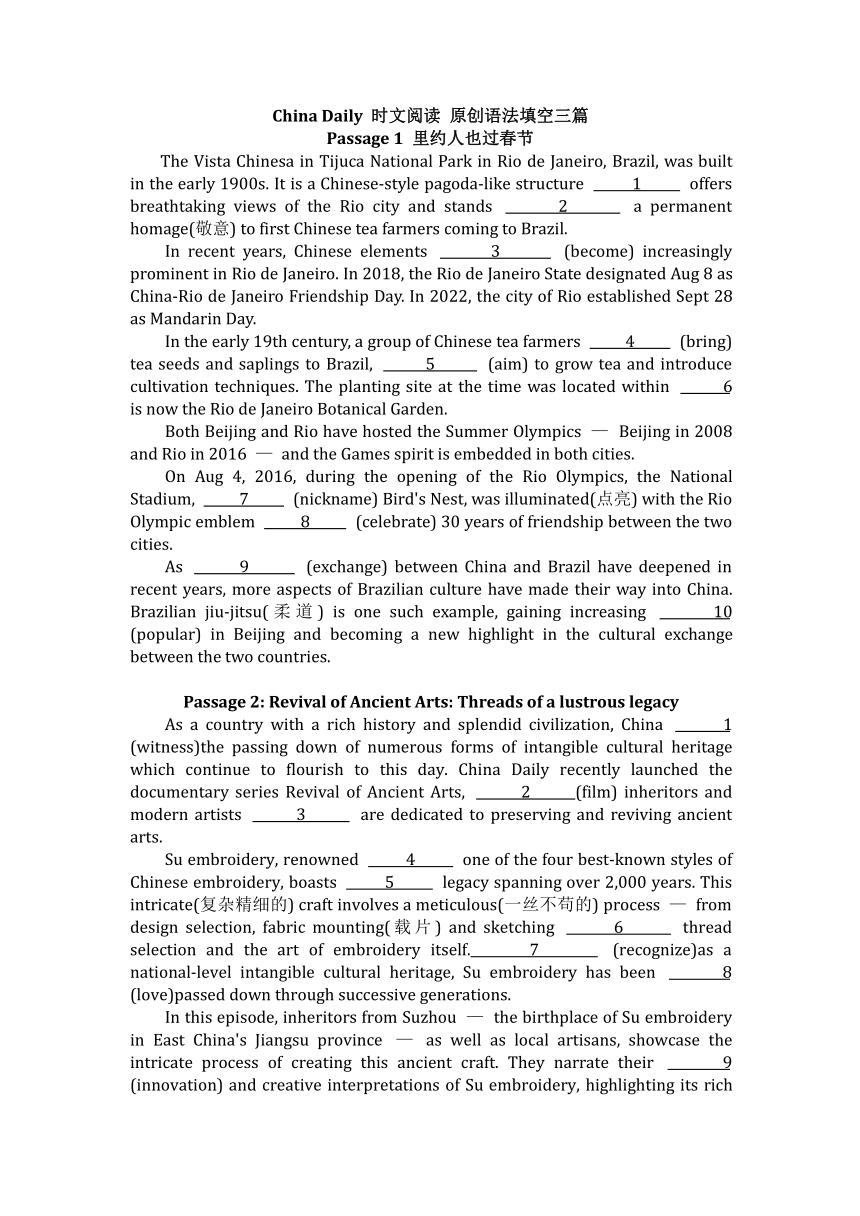
China Daily 时文阅读 原创语法填空三篇 Passage 1 里约人也过春节 The Vista Chinesa in Tijuca National Park in Rio de Janeiro, Brazil, was built in the early 1900s. It is a Chinese-style pagoda-like structure 1 offers breathtaking views of the Rio city and stands 2 a permanent homage(敬意) to first Chinese tea farmers coming to Brazil. In recent years, Chinese elements 3 (become) increasingly prominent in Rio de Janeiro. In 2018, the Rio de Janeiro State designated Aug 8 as China-Rio de Janeiro Friendship Day. In 2022, the city of Rio established Sept 28 as Mandarin Day. In the early 19th century, a group of Chinese tea farmers 4 (bring) tea seeds and saplings to Brazil, 5 (aim) to grow tea and introduce cultivation techniques. The planting site at the time was located within 6 is now the Rio de Janeiro Botanical Garden. Both Beijing and Rio have hosted the Summer Olympics — Beijing in 2008 and Rio in 2016 — and the Games spirit is embedded in both cities. On Aug 4, 2016, during the opening of the Rio Olympics, the National Stadium, 7 (nickname) Bird's Nest, was illuminated(点亮) with the Rio Olympic emblem 8 (celebrate) 30 years of friendship between the two cities. As 9 (exchange) between China and Brazil have deepened in recent years, more aspects of Brazilian culture have made their way into China. Brazilian jiu-jitsu(柔道) is one such example, gaining increasing 10 (popular) in Beijing and becoming a new highlight in the cultural exchange between the two countries. Passage 2: Revival of Ancient Arts: Threads of a lustrous legacy As a country with a rich history and splendid civilization, China 1 (witness)the passing down of numerous forms of intangible cultural heritage which continue to flourish to this day. China Daily recently launched the documentary series Revival of Ancient Arts, 2 (film) inheritors and modern artists 3 are dedicated to preserving and reviving ancient arts. Su embroidery, renowned 4 one of the four best-known styles of Chinese embroidery, boasts 5 legacy spanning over 2,000 years. This intricate(复杂精细的) craft involves a meticulous(一丝不苟的) process — from design selection, fabric mounting(载片) and sketching 6 thread selection and the art of embroidery itself. 7 (recognize)as a national-level intangible cultural heritage, Su embroidery has been 8 (love)passed down through successive generations. In this episode, inheritors from Suzhou — the birthplace of Su embroidery in East China's Jiangsu province — as well as local artisans, showcase the intricate process of creating this ancient craft. They narrate their 9 (innovation) and creative interpretations of Su embroidery, highlighting its rich cultural significance and contemporary 10 (relevant). Passage 3: Capacity of technology evolving in education The G20 Education Dialogue 1 (hold) in Beijing in October brought together more than 100 speakers, including education leaders and policymakers from G20 members, to delve(探究) into how digital 2 (transform) can enr ... ...
~~ 您好,已阅读到文档的结尾了 ~~